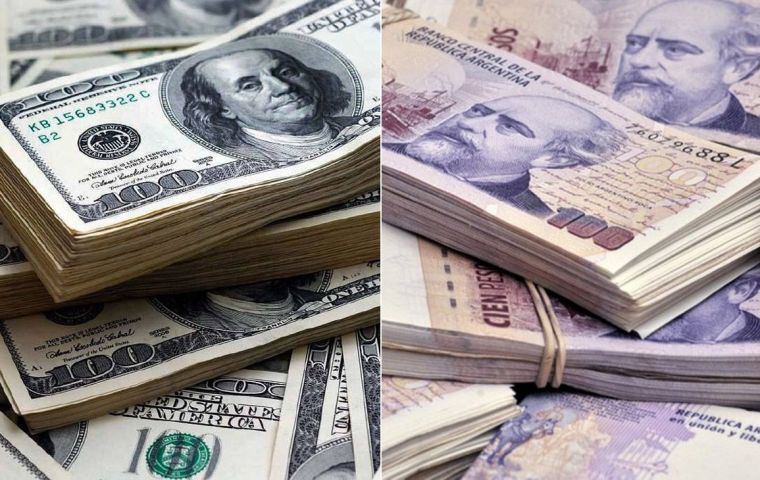MercoPress. South Atlantic News Agency
Unofficial exchange rate shows Argentina's de facto devaluation
 Whenever uncertainty rises in Argentina, US dollars bring some peace of mind
Whenever uncertainty rises in Argentina, US dollars bring some peace of mind The unofficial exchange rate (commonly referred to as “blue”) of the Argentine peso against the US dollar Friday hit an all-time high, reaching a US $ 1 = AR $ 195 parity thus matching an all-time-high of exactly one year ago (Oct.23, 2020), it was reported.
The US dollar rose AR $ 8.5 this week and AR $ 4 just Friday, something the foreign currency markets had been expecting as a result of high inflation coupled with political and economic uncertainty in addition to restrictions on the people's access to greenbacks.
The gap with the official rate is now 90%, still far from the 150% of exactly one year ago .
As the government of President Alberto Fernández desperately seeks to reverse a negativer outcome at September 12's Mandatory, Open and Simultaneous Primary (PASO) elections by handing out subsidies in as many forms as possible through the constant issuance of additional pesos, it was only natural the unofficial rate would go up, thus reflecting what the official markets are kept from doing.
Given the Government's tight pressure on anything officially channeled through banks and institutions, it is only logical people would turn to “parallel” alternatives until the Central Bank eventually comes to terms with reality and acknowledges there has been a devaluation due to the monetary expansion announced by the Government.
During September, the blue dollar rose AR $ 4.50 (+ 2.5%), after hitting a low of AR $ 139 in early April. On October 23, 2020, the rate was the same as Friday, albeit with a 150% gap against official figures.
While the “blue” dollar got all the attention Friday, the so-called cash + liquidity (CCL) dollar reached AR $ 200. It is a legal way of taking dollars out of the country, which is why it is also referred to as a “cable” dollar. To trade in CCL dollars, it is necessary to operate with an asset that is listed both in Argentina and in the international market, such as bonds or stocks.
The “free” CCL began to add new pressure after the Central Bank (BCRA) announced on October 5 yet a new batch of restrictions including caps on the amounts to be traded.
Nevertheless, most of the de facto devaluation is due to the Government printing pesos to finance 95% of its deficit between September and December.
Operators are also seeking reassurances ahead of the Nov. 14 mid-term elections and the prices of many items have gone up (even in pesos) for that reason alone.
With an agreement with the International Monetary Fund (IMF) still to be finalized and other variables at stake, uncertainly can only but grow and that will end up impacting the exchange rate. Bank deposits no matter how high and attarctive rates might be are not an option for times when cash is twice as valuable.
Financial analysts were not very optimistic either since the 2022 Budget already foresees a primary deficit of 3.3% of the country's GDP.




Top Comments
Disclaimer & comment rulesCommenting for this story is now closed.
If you have a Facebook account, become a fan and comment on our Facebook Page!